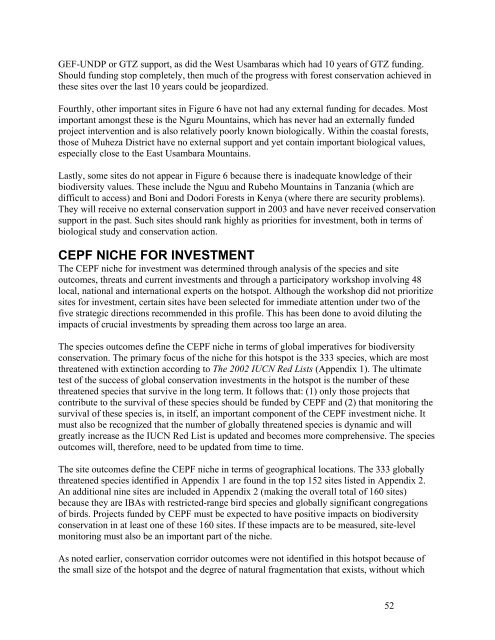Eastern Arc Mountains and Coastal Forests of Tanzania and Kenya ...
Eastern Arc Mountains and Coastal Forests of Tanzania and Kenya ...
Eastern Arc Mountains and Coastal Forests of Tanzania and Kenya ...
Create successful ePaper yourself
Turn your PDF publications into a flip-book with our unique Google optimized e-Paper software.
GEF-UNDP or GTZ support, as did the West Usambaras which had 10 years <strong>of</strong> GTZ funding.Should funding stop completely, then much <strong>of</strong> the progress with forest conservation achieved inthese sites over the last 10 years could be jeopardized.Fourthly, other important sites in Figure 6 have not had any external funding for decades. Mostimportant amongst these is the Nguru <strong>Mountains</strong>, which has never had an externally fundedproject intervention <strong>and</strong> is also relatively poorly known biologically. Within the coastal forests,those <strong>of</strong> Muheza District have no external support <strong>and</strong> yet contain important biological values,especially close to the East Usambara <strong>Mountains</strong>.Lastly, some sites do not appear in Figure 6 because there is inadequate knowledge <strong>of</strong> theirbiodiversity values. These include the Nguu <strong>and</strong> Rubeho <strong>Mountains</strong> in <strong>Tanzania</strong> (which aredifficult to access) <strong>and</strong> Boni <strong>and</strong> Dodori <strong>Forests</strong> in <strong>Kenya</strong> (where there are security problems).They will receive no external conservation support in 2003 <strong>and</strong> have never received conservationsupport in the past. Such sites should rank highly as priorities for investment, both in terms <strong>of</strong>biological study <strong>and</strong> conservation action.CEPF NICHE FOR INVESTMENTThe CEPF niche for investment was determined through analysis <strong>of</strong> the species <strong>and</strong> siteoutcomes, threats <strong>and</strong> current investments <strong>and</strong> through a participatory workshop involving 48local, national <strong>and</strong> international experts on the hotspot. Although the workshop did not prioritizesites for investment, certain sites have been selected for immediate attention under two <strong>of</strong> thefive strategic directions recommended in this pr<strong>of</strong>ile. This has been done to avoid diluting theimpacts <strong>of</strong> crucial investments by spreading them across too large an area.The species outcomes define the CEPF niche in terms <strong>of</strong> global imperatives for biodiversityconservation. The primary focus <strong>of</strong> the niche for this hotspot is the 333 species, which are mostthreatened with extinction according to The 2002 IUCN Red Lists (Appendix 1). The ultimatetest <strong>of</strong> the success <strong>of</strong> global conservation investments in the hotspot is the number <strong>of</strong> thesethreatened species that survive in the long term. It follows that: (1) only those projects thatcontribute to the survival <strong>of</strong> these species should be funded by CEPF <strong>and</strong> (2) that monitoring thesurvival <strong>of</strong> these species is, in itself, an important component <strong>of</strong> the CEPF investment niche. Itmust also be recognized that the number <strong>of</strong> globally threatened species is dynamic <strong>and</strong> willgreatly increase as the IUCN Red List is updated <strong>and</strong> becomes more comprehensive. The speciesoutcomes will, therefore, need to be updated from time to time.The site outcomes define the CEPF niche in terms <strong>of</strong> geographical locations. The 333 globallythreatened species identified in Appendix 1 are found in the top 152 sites listed in Appendix 2.An additional nine sites are included in Appendix 2 (making the overall total <strong>of</strong> 160 sites)because they are IBAs with restricted-range bird species <strong>and</strong> globally significant congregations<strong>of</strong> birds. Projects funded by CEPF must be expected to have positive impacts on biodiversityconservation in at least one <strong>of</strong> these 160 sites. If these impacts are to be measured, site-levelmonitoring must also be an important part <strong>of</strong> the niche.As noted earlier, conservation corridor outcomes were not identified in this hotspot because <strong>of</strong>the small size <strong>of</strong> the hotspot <strong>and</strong> the degree <strong>of</strong> natural fragmentation that exists, without which52
















